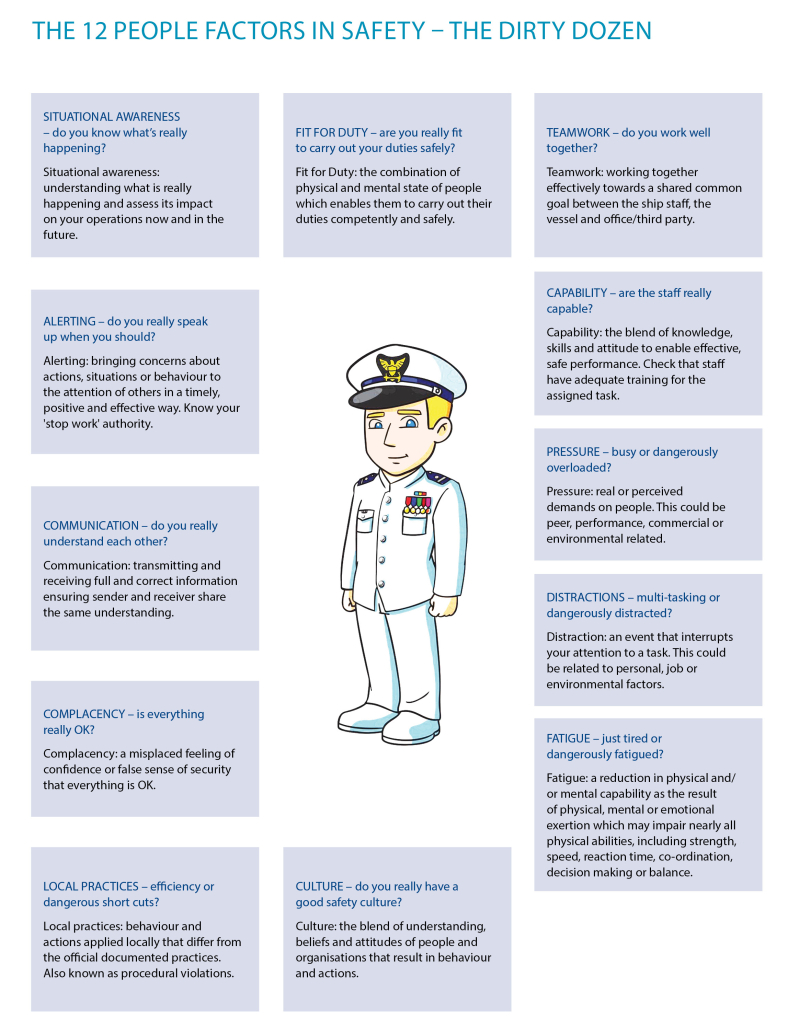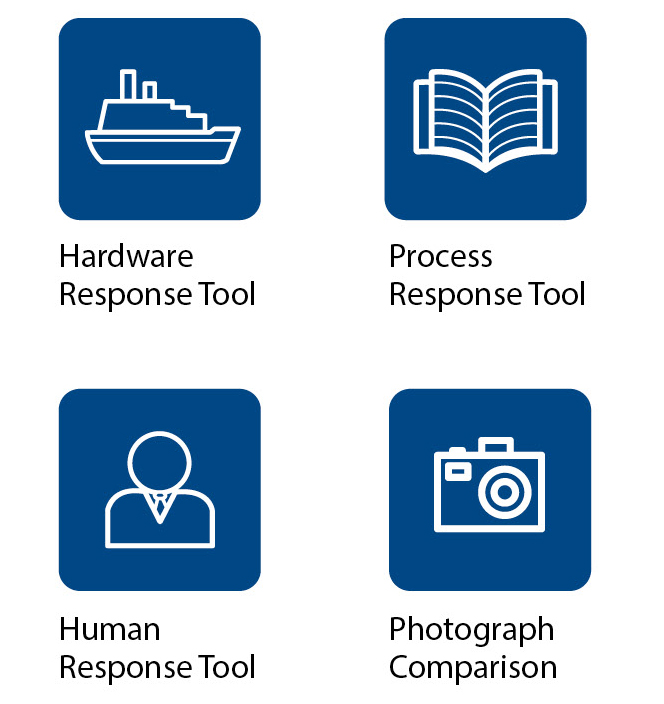
The role of the ‘human element’ in safety management, highlights a Fleet Management news source.
The ‘human element’
The ‘human element’ plays an important role in Safety Management. The majority of accidents, incidents, and failures have been found to be potentially avoidable if people’s understanding, actions, and behaviors were different.
There are a wide range of factors that can result in adverse outcomes. A consistently occurring factor throughout almost all of these is the human element – including the knowledge, actions or behaviours of the people involved.
The human element reflects a person’s ability and capability to deal effectively and safely with the complexity, difficulty and pressures of their tasks, both in routine operations and emergency situations.
‘The Dirty Dozen’ – the most significant people factors which affect maritime safety
‘The Dirty Dozen’ are the most common conditions which can influence or act as pre-cursers to human error, leading to adverse outcomes. We encourage all stakeholders involved – including ship owners, operators and managers, as well as ship staff – to become familiar with these principles.
Global trends show that the top contributory people factors resulting in accidents or compromising the safety management system are:
- Lack of situational awareness and risk awareness while performing the task;
- Complacency and local practices, in not following company procedures and taking shortcuts under self-perceived pressures;
- Teamwork and Alerting, including failure to use the ‘stop work’ authority when noticing another team member not following procedures.
As non-compliance with safety procedures is a major contributory factor in incidents, we need to maintain and continue to build a robust safety culture, through driving compliance. All onshore staff and seafarers should fully understand the safety procedures of the task they are undertaking as well as our Behavior-based safety program, SAFER+ T-CUP – “Total Control Under Pressure”.
The new SIRE 2.0 programme
The industry recognises that the human element plays an important role in safety management. The new SIRE 2.0 inspection regime aims to report on the quality of a vessel and its ship staff more accurately, as well as indicate future likely performance.
As part of this, SIRE 2.0 features enhanced tools – such as the Human Response Tool and Performance Influencing Factors – as well as strengthened governance processes and more in-depth reporting outcomes, following a risk-based approach. The new SIRE 2.0 regime is expected to become operational in the third quarter of 2023, in a phased manner.
SIRE 2.0 Inspection Tablet and Question Library
The Inspection Tablet has a pre-loaded Inspection Editor that allows an inspector to gather and record information during an inspection – including photographs – and to create a unique vessel-specific VIQ for each inspection and finally the SIRE report.
The SIRE 2.0 Question Library has been built on the principle of barrier management, aiming to identify when a failure in a task, procedure, or item of structure, machinery or equipment could result in a potential weakening of a barrier.
The four key tools used within the inspection process are:
- Hardware Response Tool – where the questions refer to vessel structure, machinery, outfitting, or equipment.
- Process Response Tool – where the questions require a response against a process (procedure) based question.
- Human Response Tool – where the questions refer to the familiarity of vessel ship staff with a company procedure, written process or the use or operation of machinery or equipment.
- Photograph Comparison – to allow the reader of the report to assess the physical and cosmetic condition of the vessel.

The significant role of the human element in safety is reflected in our FLEET safety procedures and the new industry-wide SIRE 2.0 inspection regime. Therefore, proactively managing and being aware of the role of the human element – both within ourselves and colleagues we’re working with – is key to our success in preventing accidents and achieving good inspection results.
The Human Response Tool and Performance Influencing Factors
In SIRE 2.0, the Human Response Tool considers Performance Influencing Factors (PIFs). These are the foundational blocks of human performance that are known to influence or shape human performance. They can enhance and assist human performance, or negatively affect it.
The Performance Influencing Factors are categorised as follows:
- Recognition of safety criticality of the task or associated steps
- Custom and practice surrounding the use of procedures
- Procedures are accessible, helpful, understood and accurate for the task
- Team dynamics, communications and coordination with others
- Evidence of stress, workload, fatigue and time constraints
- Factors such as morale, motivation and nervousness
- Workplace ergonomics (e.g., signage, tools, layout, space, noise, light, heat)
- Human-machine interface (e.g., controls, alarms)
- Opportunities to learn or practice
As we prepare to conduct any task, we should remember the Dirty Dozen and the Performance Influencing Factors and consider which of these may be occurring. As human beings, none of us are perfect. However, all of us should consider safety as our key priority and take the necessary precautions to ensure we and our team members can remain safe at work.
Did you subscribe to our newsletter?
It’s free! Click here to subscribe!
Source: Fleet Ship















